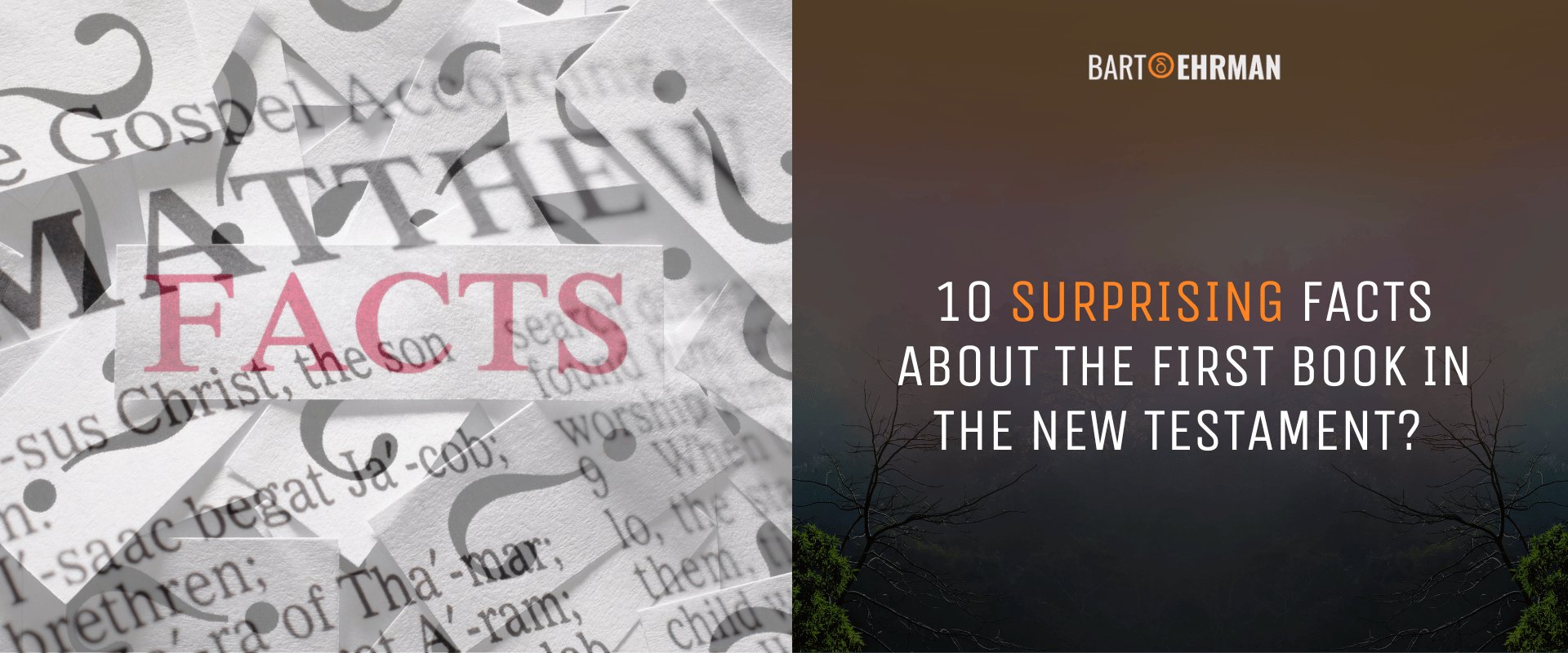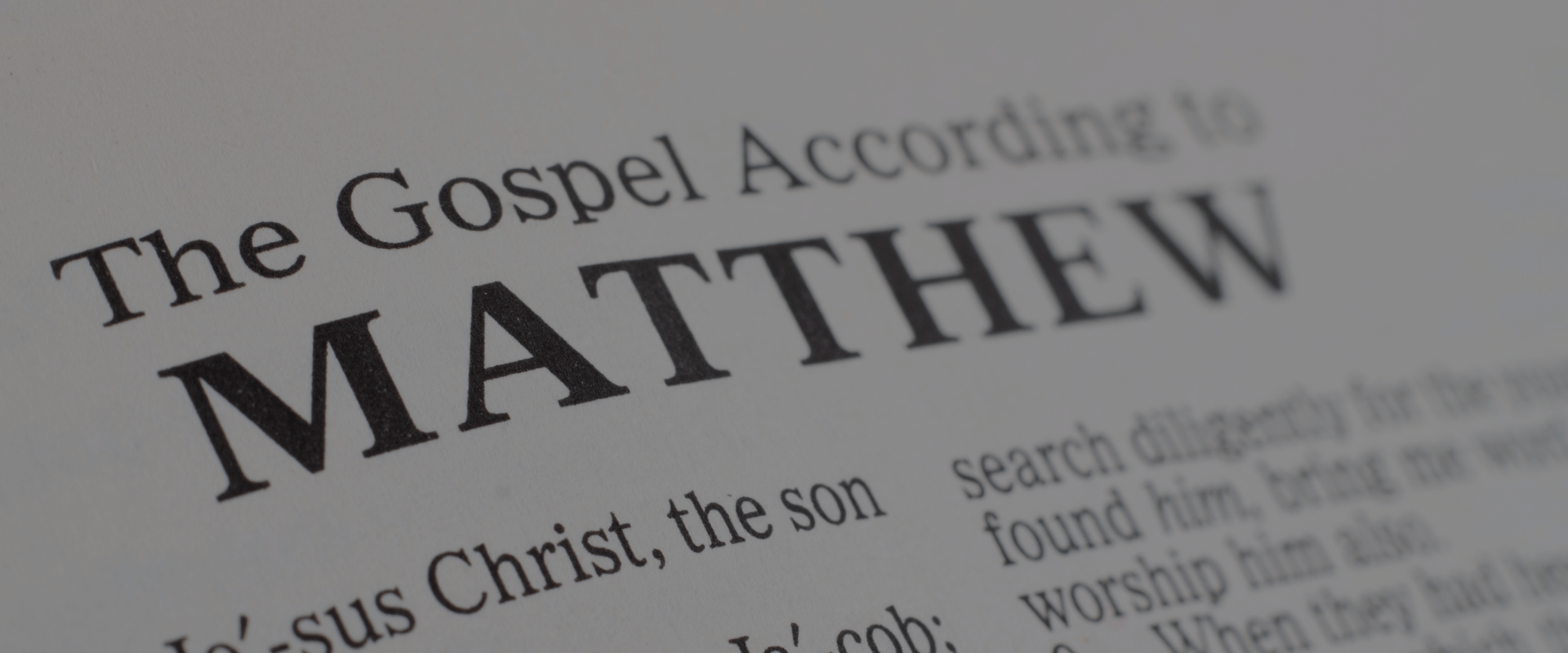10 Surprising Facts About the First Book in the New Testament?

Written by Joshua Schachterle, Ph.D
Author | Professor | Scholar
Author | Professor | BE Contributor
Verified! See our editorial guidelines
Verified! See our guidelines
Date written: February 12th, 2025
Disclaimer: The views and opinions expressed in this article belong to the author and do not necessarily match my own. - Dr. Bart D. Ehrman
The Gospel of Matthew, the first book in the New Testament, is often regarded as the foundational account of Jesus’ life, teachings, and legacy. But beyond its well-known narrative, there are many surprising details about Matthew that challenge common assumptions and offer a deeper understanding of its context and significance.
Matthew presents a unique vision of Jesus and his mission. It also breaks with certain biblical traditions in fascinating ways. In this article, we’ll explore ten lesser-known facts about the Gospel of Matthew that shed light on its complex and distinctive role in the Christian tradition.

Gospel of Matthew Overview
The Gospel of Matthew was written to Jewish Christians about half a century after Jesus’ death. The author was not an original disciple of Jesus, nor did he likely live in the Palestine in which Jesus spent his entire life. He did, however, pass down many stories, sayings, and traditions from earlier times and texts.
Like the other three Gospels, Mark, Luke and John, the Gospel of Matthew is the story of Jesus’ birth, life, death, and resurrection. It also represents the significance of Jesus for the author and his community. It was written long before any definitive break between Judaism and Christianity and thus manages to be both distinctively Jewish and inviting to Gentiles.
Now that we know some general details about what book starts the New Testament, let’s look at 10 interesting facts about the Gospel of Matthew.
#1 It was originally written anonymously.
Although we know this particular version of Jesus’ life story as the Gospel of Matthew, that title was not part of the original writing. In fact, the book was originally written without any authorial attribution, as we know from our earliest manuscripts. Christians later added the title in the late 2nd century CE, about a century after the book was written.
In his commentary on Matthew, Walter Wilson suggests that the author may not have signed his work because he viewed it as a composition by his community rather than as a reflection of his individual perspective.
#2 It is not the earliest written Gospel in the Bible.
Because it is the first book in the New Testament and the first Gospel in our current biblical canon, many assume that Matthew was the first Gospel written. However, scholars have known for many years that our earliest written Gospel was Mark, composed 10-20 years before Matthew. So why does Matthew come first in the Bible?
In her Introduction to the Synoptic Gospels, Pheme Perkins notes that some early Christians believed Mark, which is shorter than Matthew, was merely a terse summary of the events in Matthew. In addition, while Mark has no birth story, beginning instead with Jesus’ baptism, Matthew contains one This may have suggested to early Christians that Matthew was privy to more information about the life of Jesus than Mark.
#3 It depicts Jesus as a new Moses.
In the Hebrew Bible, Moses is depicted as the liberator of the Israelites from their slavery in Egypt. However, he is also known as the lawgiver, the one who received the Ten Commandments directly from God and gave them to the Israelites so that they would know how to please God.
Matthew, which as John Kampen writes, is widely known as the most Jewish of the four canonical Gospels, portrays Jesus as a new Moses, reinterpreting the Jewish law for those who follow him. Unlike the Jesus of the other three Gospels, Matthew’s Jesus spends a lot of time discussing correct understandings of this law, even demanding that his followers be stricter about law observance than the Pharisees for whom interpretation and observance of the law was the principal focus.
FREE COURSE!
WHY I AM NOT A CHRISTIAN
Raw, honest, and enlightening. Bart's story of why he deconverted from the Christian faith.
Over 6,000 enrolled!
#4 Its genealogy of Jesus includes five women.
Ancient genealogies generally traced family lineages only through men. In 1 Chronicles 1-9, for example, there is an extensive genealogy beginning with Adam which never mentions a single woman. However, the Gospel of Matthew begins with a genealogy of Jesus which includes five women. What is the significance of this?
In addition to Mary the mother of Jesus, four women from the Hebrew Bible are mentioned. As Bart Ehrman points out, all four “were involved with sexual activities that were viewed as scandalous by outsiders but that furthered the purposes of God.” These include Tamar, who disguised herself as a prostitute in order to deceive her father-in-law into having sex with her, Rahab, a prostitute in Jericho, Ruth, who seduced her kinsman, and Bathsheba who committed adultery with (or was raped by) King David. Perhaps, Ehrman suggests, Matthew wanted to show that God can use even sexual scandals — like a pregnant virgin who is suspected of infidelity by her husband — to advance his plans.
#5 It was probably written in Antioch, Syria.
The Gospel of Matthew was written in Koine Greek rather than the Aramaic language spoken in Israel at the time (and spoken by Jesus and his disciples). For this and other reasons, most scholars concur that Antioch, Syria is the most likely place where Matthew was written.
We know that Greek was the primary language spoken in Antioch, the result of the earlier spread of Greek language and culture by Alexander the Great. In addition, Aaron Gale, in the Jewish Annotated New Testament, writes that among the four Gospels, only Matthew mentions that during his lifetime, Jesus was acclaimed in Syria. Whether Jesus was known in Syria during his lifetime, this sole direct reference to his following in Syria seems unlikely to be a mere coincidence.
#6 It used Mark as a source.
Despite what some early Christians believed, Mark was not a summary of Matthew. In fact, in some ways, it was the other way around.
As Bart Ehrman notes, scholars have known for many years that Matthew (and Luke) used Mark, the earliest of the four written Gospels, as a source. In fact, in many cases, Matthew used the exact same Greek phrases to narrate events first written about in Mark. He also tells these events in the same order as Mark.
#7 Matthew’s primary audience were Jewish Christians.
Some early Jews believed the Hebrew Scriptures contained prophecies about the advent of the Messiah. The author of Matthew seems to have agreed with this. He thus claimed that certain prophecies from the Hebrew Bible were “fulfilled” by Jesus.
In fact, we know that several people in Jesus’ time and place claimed to be the Messiah, but Matthew used texts from the Hebrew Bible to maintain that Jesus was the true Messiah. It’s safe to assume, then, that Matthew’s principal audience were Jews who believed that Jesus was the Messiah. However, it’s clear from references to “all nations” becoming disciples in Matthew that gentiles were admitted to Matthew’s community as well, probably due to Jewish Christian conflicts with other Jewish groups.

#8 It’s the only Gospel that mentions the Magi.
The Magi, also known as the Wise Men or the Three Kings, are characterized as prominent foreign men who visit and honor Jesus just after his birth, bringing him gifts of gold, frankincense, and myrrh. Despite the fact that tradition says there were three of them, Matthew never actually confirms this. That number is derived from the number of gifts they brought.
Scholars have long speculated about the identity of these Magi and their function in the story. It is interesting that they are not Jews, possibly an attempt by Matthew to note the universal significance of Jesus’ birth. The word Magi (singular: Magus) is a Persian-derived word for priests in the Zoroastrian tradition, lending further credence to Matthew’s notion that Jesus came not just for the Jews, but for all people.
#9 It’s the only Gospel that mentions the Slaughter of the Innocents.
Speaking of the Magi, Matthew says that after they inform King Herod that a new king of the Jews had been born, Herod decides to order the killing of all baby boys two years old or younger to eliminate royal competition — an event known as the Slaughter of the Innocents. Fortunately, an angel warns Joseph, and he and his wife and infant son flee to Egypt.
The fact that this only occurs in Matthew is one reason why it’s unlikely that this mass murder is a historical fact. No other Gospel mentions it, nor do any of our other sources. Surely, such a heinous crime committed by a king would have been mentioned by someone else. Instead, Matthew uses the story to show how it further fulfills messianic prophecies that prove that Jesus is the Messiah.
#10 It uses more than 130 quotes and allusions to the Hebrew Bible.
In the time when Matthew was written (80-95 CE), Scripture meant the Hebrew Bible exclusively. In order to accomplish his task of proving that Jesus was indeed the Messiah, Matthew refers frequently to Hebrew Bible quotations and shows how Jesus fulfills them as prophecy.
For this purpose, he often says “so that the Scripture would be fulfilled.” In the flight to Egypt, for instance, he quotes a verse from Hosea 11:1, which says “Out of Egypt have I called my child.” For Matthew this, and other references to the Hebrew Bible, predicted the events of Jesus’ life and thus validated his claims that Jesus is the long-awaited Messiah.
Conclusion
The Gospel of Matthew is the first book in the New Testament. As such, it implicitly represents the life and teachings of Jesus as a transition from the ancient Judaism of the Hebrew Bible prophecies to the fulfillment of those prophecies in Jesus. Matthew is unique, even among the canonical Gospels, in several ways.
It is steadfastly Jewish, seeing Jesus as a new Moses who interprets the Jewish Law correctly and lives it strictly. It also refers frequently to Hebrew Bible prophecies as part of its overall claim that Jesus is the Messiah. However, it also approves the inclusion of Gentiles among Christian communities, as long as they follow Jesus’ interpretation of the Jewish Law.
Additionally, it is the only Gospel where we find the visit of the Magi to the infant Jesus, as well as the subsequent Slaughter of the Innocents by King Herod. It was likely written in the Syrian city of Antioch and definitely used the Gospel of Mark as its principal source for the events and chronology of Jesus’ life.
FREE COURSE!
WHY I AM NOT A CHRISTIAN
Raw, honest, and enlightening. Bart's story of why he deconverted from the Christian faith.
Over 6,000 enrolled!
